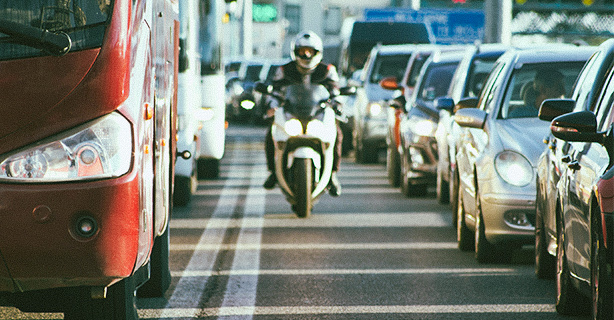The basics of lane splitting on your motorcycle
0 min. read
What is lane splitting?
Lane splitting is a motorcycle riding technique in which a rider passes between lanes of slow-moving or stopped traffic on a multilane road while traveling up to 10mph faster than the other vehicles. The motorcyclist then returns to an established lane when traffic flow resumes.
Is lane splitting legal?
While the practice is common in other countries, here in the U.S., lane splitting is either explicitly or implicitly illegal in most states. These decisions fall under individual state legislatures' jurisdictions. Where lane splitting is legal, the guidelines are likely developed in conjunction with the highway patrol or state police, along with the state motor vehicle division.
Here's a look at several states with current or prospective laws that could impact your ability to lane-split as you ride:
California
California is currently the only state to have fully legalized lane splitting. Then-governor Edmund G. Brown, Jr. signed California assembly bill 51 (AB-51) into law on August 19, 2016. To quote the bill:
“lane splitting” means driving a motorcycle, as defined in Section 400, that has two wheels in contact with the ground, between rows of stopped or moving vehicles in the same lane, including on both divided and undivided streets, roads, or highways.
AB-51 makes it legal for riders to split lanes, which had been tolerated by the California Highway Patrol (CHP) for years while its legal status was unofficial. The law also required the California Highway Patrol (CHP) to develop educational lane splitting guidelines .
Since the guidelines direct both enforcement of the law and education of the motoring public, this has been a significant victory for California motorcycle riders—and potentially a model for other states.
Utah
While lane splitting isn't currently legal in Utah, a lane-filtering law has been in effect since 2019. Keep in mind, lane filtering isn't the same as lane splitting, as we discuss below. But when drivers become used to filtering, it can help them see the benefits in reduced congestion that legal lane splitting can provide.
Massachusetts
The Commonwealth of Massachusetts explicitly forbids motorcycle lane splitting. Here's a relevant excerpt from Part 1, Title XIV, Chapter 89, section 4A of its general laws:
When any way has been divided into lanes, the driver of a vehicle shall so drive that the vehicle shall be entirely within a single lane.
Texas
Efforts to legalize lane splitting in Texas have been active since at least 2015, but all proposed bills have failed to move beyond the Senate Transportation Committee.
The purpose and benefits of lane splitting
When done safely, lane splitting can benefit both motorcycle riders and other drivers. It helps motorcyclists reduce their risk of being rear-ended, as they can move from a stopped lane of traffic and flow forward between slow or stopped traffic. And since a motorcycle occupies the same lane space as a car, in bumper-to-bumper traffic, lane splitting can help reduce congestion.
Best practices for lane splitting
As long as you're riding in a state where lane splitting is legal, here's how to do it safely:
Only split lanes in between the two left most lanes. The right lanes have more vehicles changing lanes for on- and off-ramps.
Make sure you have enough room ahead to pass safely between traffic; you should have two feet of space on either side of your motorcycle.
Scan the road ahead, since you'll have limited escape route options.
Watch for cars trying to change lanes.
Ride slowly in a gear that allows for good control and reduces your exhaust sound level—higher speeds and louder noise can startle drivers.
Be prepared to stop by covering the brakes and clutch with two fingers.
Stay ready to merge back into a traffic lane when traffic resumes normal speed.
Lane splitting vs. lane filtering
It's important to understand the differences between lane splitting and lane filtering. Lane filtering is a technique specifically intended for intersections with traffic lights. You “filter” your way between stopped vehicles to reach the front of the line at a red light. This helps reduce the space your motorcycle occupies in the stopped traffic lanes.
When the light turns green, your motorcycle's rapid acceleration allows you to move ahead and merge back into the traffic lanes. Of course, there's always a chance another driver runs the red light, so be sure to check the cross traffic before advancing.
The hazards of lane splitting
While lane splitting is often safer than requiring motorcycles to sit in lanes of stopped traffic, it's not without risks, including:
Nearby vehicles that make sudden moves without signaling
Emergency vehicles on the shoulder that cause traffic to shift out of the way and reduce the space around you
Extra-wide side mirrors on other vehicles
Ladders, lumber, and other objects sticking out of pickup beds or car windows
Broken, cracked, or rutted pavement between lanes
Raised reflectors along the lane divider markings
Poor riding conditions, including rain, snow, wind, and darkness
Whenever you ride in a state where lane splitting is legal, review this guide and follow the best practices outlined here. It's up to all of us to set a positive, safe example as riders. We're here to help.
Related links
Lane splitting isn’t the only element of riding that varies by state. Check out your state’s motorcycle insurance requirements to ensure you’ve got the coverage you need.
The safety habits lane splitting requires—situational awareness, patience, and balance—are also important when riding through road construction.
The general information in this blog is for informational or entertainment purposes only. View our blog disclaimer.
*Data accuracy is subject to this article's publication date.







